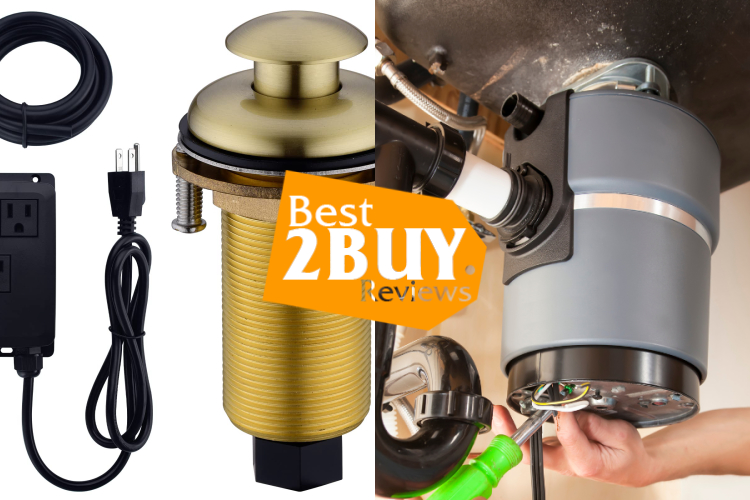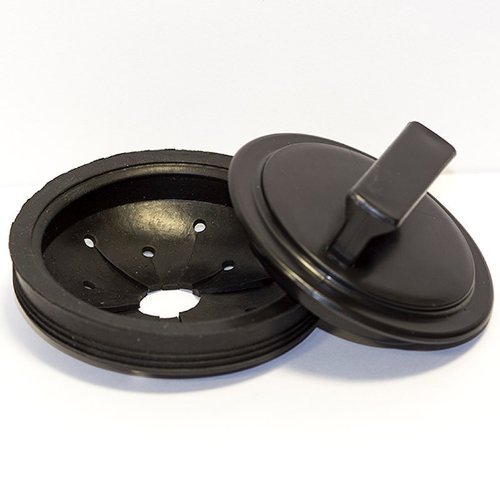How to Choose the Garbage Disposal Parts
Garbage Disposal Parts: A Comprehensive Guide

- 1. Garbage Disposal Parts: A Comprehensive Guide
- 1.1. What Is a Garbage Disposal?
- 1.2. Types of Garbage Disposals
- 1.2.1. 1/3 Horsepower
- 1.2.2. 1/2 Horsepower
- 1.2.3. 3/4 Horsepower
- 1.2.4. 1 Horsepower
- 1.2.5. More Than 1 Horsepower
- 1.2.6. Batch Feed
- 1.2.7. Continuous Feed
- 2. How to Choose the Best Garbage Disposal
- 2.1. Considerations When Purchasing a New Garbage Disposal
- 2.1.1. Space Requirements
- 2.1.2. Choice of Material
- 2.1.3. Size Matters
- 2.1.4. Additional Features to Consider
- 2.2. Cost
- 2.1. Considerations When Purchasing a New Garbage Disposal
If you've reached the point where you're thinking about either upgrading your kitchen sink with a garbage disposal or replacing an existing one, the array of available models and the various factors to take into account might appear overwhelming. Factors to ponder include grinding capacity, dimensions, and operational mechanisms. Continue reading to gain a better understanding of the garbage disposal options at your disposal, aiding you in choosing the perfect model for your needs.
What Is a Garbage Disposal?
A garbage disposal, situated beneath the kitchen sink basin and powered by electricity, is a device designed to break down food waste that is washed down the sink drain, reducing it to a size that can easily flow through the plumbing system.
Types of Garbage Disposals
The primary factor to consider when selecting a garbage disposal, which also significantly impacts its price, is the horsepower (hp) of the motor. In most residential garbage disposals, electric motors typically range from 1/3 to 1 hp. Another crucial consideration is whether you prefer a batch feed or continuous feed model.
1/3 Horsepower
The lowest available horsepower for garbage disposals is 1/3 hp. While they may appear cost-effective, they come with limitations. These units tend to jam easily and often feature the cheapest internal components, which are prone to rusting quickly. Consider this option only for very limited or temporary use, such as in a vacation home rarely used. They typically cost less than $100.
1/2 Horsepower
A 1/2 horsepower model is the minimum recommended for typical home use, and you can find one for around $100. These units are smaller than 3/4-hp and 1-hp disposals, making them suitable for compact spaces. A 1/2-hp disposal is a good choice if you don't use it frequently and can be cautious not to overload it. It's advisable to choose a 1/2 horsepower garbage disposer with stainless steel grind components whenever possible for increased durability. These disposals tend to be noisier, so running plenty of water with them is essential to assist in food waste disposal.
3/4 Horsepower
A 3/4 horsepower unit is an excellent size for most kitchens. It should suffice for a family of three to five people. A disposal of this size has ample power to handle leftovers and more. Many 3/4-hp disposals, like the InSinkErator Compact, can even grind challenging waste like potato peels and celery without issues. They are less likely to jam, often come with added features, and feature stainless steel grind components for extended lifespan. Most disposals in this category also offer better sound insulation, making them quieter than 1/2 horsepower units. However, they tend to be larger physically, so ensure you have sufficient space beneath your kitchen sink. You can find a reliable 3/4-hp disposal for under $200.
1 Horsepower
If you need to grind tough materials like chicken bones, fruit rinds, or coffee grounds, a 1 horsepower disposal is the right choice. Most 1 horsepower models are top-tier, such as the InSinkErator's Evolution Excel. These disposals are typically quieter than even 3/4 horsepower units due to better insulation. They feature complete stainless steel grinding chambers, increased waste capacity, and are virtually jam-proof. They are relatively large, requiring ample space under the sink. While the price range varies depending on features, you can find them from as low as $150 for basic models to over $300 for more advanced ones.
More Than 1 Horsepower
Garbage disposals with 2 hp to 3 hp are typically used in commercial kitchens. For households with eight or more people, a 1 1/4 to 2 hp disposal is suitable. As you increase the horsepower, the price also increases accordingly.
Batch Feed
Batch feed models operate in batches and only run when a stopper is placed over the disposal opening to activate it. They are ideal for households with active and curious children, as the stopper prevents items from accidentally falling into the disposal. To use a batch feed disposal, you must place food waste inside it and insert the stopper before turning it on. These units have more intricate construction compared to continuous feed models and do not require a separate switch or button for operation.
Continuous Feed
Continuous feed models activate with the flip of a switch and run until turned off. You can add food waste while the disposal is running. Some models offer auto-reverse functions, advanced grinding capabilities, and special circuitry to reduce jamming. Certain units also include splash guards to prevent items from splattering while adding food waste. If you have young children, exercise caution when using this type of disposal to keep them away from the sink.
How to Choose the Best Garbage Disposal
Considerations When Purchasing a New Garbage Disposal
Space Requirements
A garbage disposal serves the purpose of processing food waste in kitchen sinks and is typically installed beneath the sink, connecting between the drain and the trap. Fortunately, most kitchen sinks adhere to standard drain hole sizes, which range from 3.5 to 4 inches, making garbage disposals compatible with a variety of sinks.
It's important to note that these disposals were initially designed to work with plumbing systems that discharge into municipal sewer systems. However, some manufacturers have developed disposals that are safe for septic systems, provided they are exclusively used for disposing of food scraps. Certain septic system units even feature cartridges that introduce natural microorganisms into the food waste, aiding in its decomposition within the septic tank. Additionally, these cartridges often contain citrus-scented fluid to control odors emanating from the sink and drain. Replacement cartridges are typically affordable, with some lasting up to six months.
Choice of Material
For durability, consider opting for garbage disposals primarily constructed from stainless steel components. Stainless steel can endure a lifetime of use, often outlasting the motor itself. In contrast, disposals with plastic parts may eventually deteriorate and crack, although they should hold up well if not subjected to excessive boiling water. Models utilizing galvanized steel should be avoided, as they tend to rust quickly.
Size Matters
The size of the disposal unit correlates with its horsepower, which should be chosen based on your cooking habits and family size. Disposal unit dimensions can vary, with most falling within the range of 10 to 15 inches in height, 5 to 9 inches in width, and 6 to 13 inches in depth.
Additional Features to Consider
- Brand: InSinkErator, owned by Emerson Electric, is a popular and widely available garbage disposal brand, offering a variety of models in different sizes and configurations. Other reputable brands include Waste King, Waste Maid, and Moen. Major brands often provide better warranties and easier access to spare parts.
- Warranty: Garbage disposals typically have a lifespan of 8 to 15 years, with warranties ranging from one to 10 years. Higher-priced disposals often come with longer warranties. However, most disposals outlive their warranties, so purchasing an expensive unit solely for an extended warranty may not be necessary.
- Noise Level: Manufacturers incorporate sound-deadening features into garbage disposals to reduce noise. If noise is a concern, look for disposals with features like nylon-coated grinding parts, insulated mounting baffles, and other sound-dampening technology.
- Power Cord Inclusion: Cheaper garbage disposals may not come with a power cord, necessitating a separate purchase, which can add around $15 to the overall cost. Alternatively, some models are designed for professional installation and require connection by an electrician to your electrical system.
- Septic System Enzymatic Reservoir: This feature can provide support to your septic system by introducing additional enzymes, promoting a healthy septic tank environment.
Cost
On the lower end of the price spectrum, you can acquire a garbage disposal for less than $100, suitable for a household of two. However, if you have a larger family or frequently engage in cooking activities, you might find it worthwhile to invest between $200 and $300 in a 1-horsepower unit equipped with special features. Opting for a batch feed model instead of a continuous feed one could significantly increase your average expenditure. Depending on the brand, units with the same horsepower may double in price.
When it comes to the installation of a garbage disposal for the first time, you should anticipate expenses of around $500. This includes the cost of a new receptacle, fittings, switches, and labor, with the installation process typically taking approximately 1 to 2 hours. Conversely, replacing an old unit is a more cost-effective option, with a budget of roughly $150 to $200 sufficing for this task.
A garbage disposal is a beneficial inclusion for any kitchen, enhancing the convenience and eco-friendliness of food waste disposal. To ensure the efficient upkeep and resolution of potential problems, it's crucial to grasp the different components of a garbage disposal and their respective roles. Maintaining its optimal performance requires routine cleaning, appropriate usage, and regular inspections. Always refer to the manufacturer's guidelines and enlist professional help if needed. With diligent care, your garbage disposal can continue to serve you effectively for years to come.











